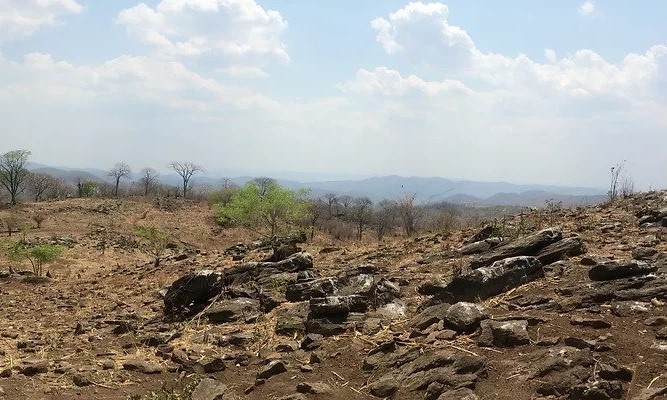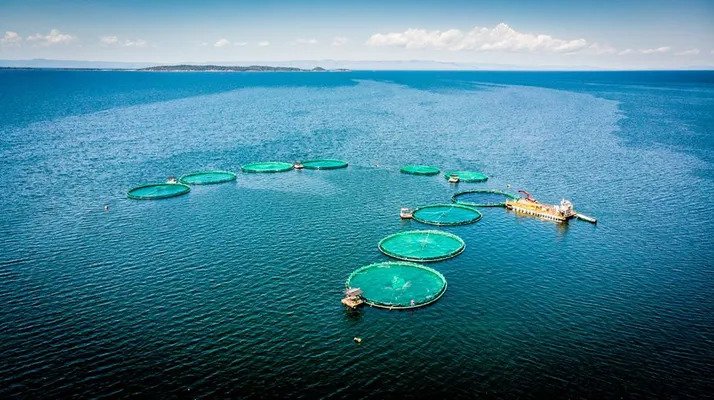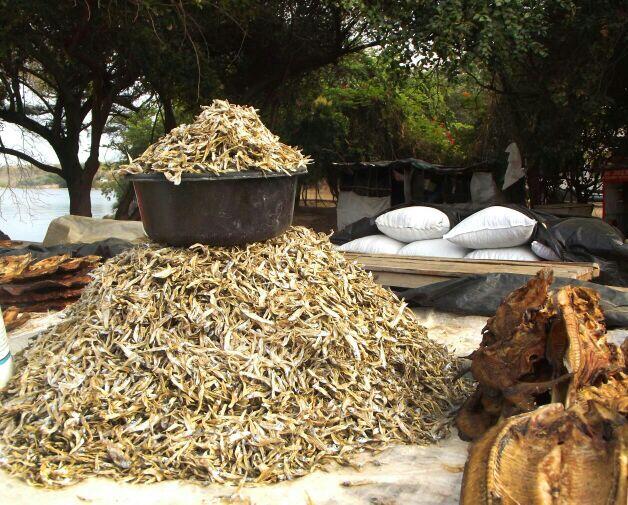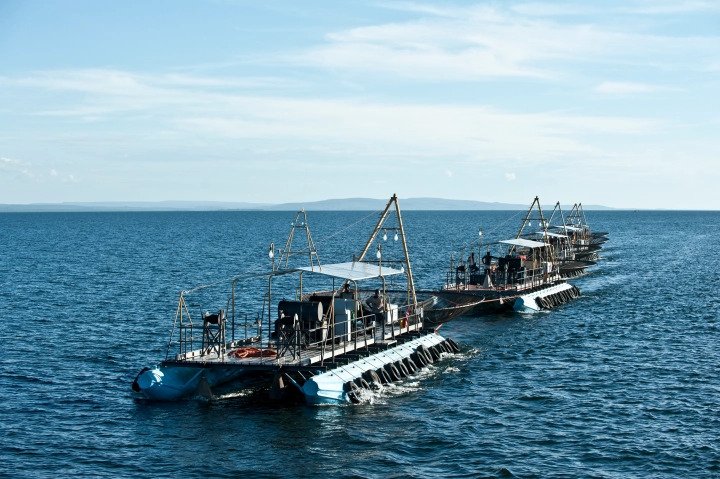Siavonga: Life on a man-made lake
- 10 minutes read - 2087 wordsSiavonga is the largest shoreline town on the Zambian side of Lake Kariba. It’s top four economic mainstays are hydropower from Kariba Dam, wild kapenta fishing, tilapia farming on the lake, and tourism. Tourism is the reason I had come to town in April, 2022. I had come to see for seeing’s sake; and to touch, for the first time, the dam and the lake it holds back.
The dam is an enormous hunk of curved concrete. At a glance, the dam’s downstream face embarks on a vertiginous curvy rise from a base at the bottom of the gorge to the roadway on top. The drop back down to the river, to the heavy machinery working in and around the plunge pool: cranes, coffer dam pieces rising out of the water, speed boats zooming about on the river is hypnotic—carrying certain emanations suggestive of an impending fall over the edge. One takes a step back and peers over the side-rail rather than lean over. Spiritual possession and other such states of altered consciousness are mysteries to many, me included. If spirit visits to bodies they chose to haunt are without foreshadowing, it would be inconvenient if a hitherto unknown spirit kicked in; full of ideas for experimentation, as one stood contemplating the plunge over the edge of a 128 meter (420 ft) wall, with massive rocks exposed at its base.
I had the briefest of interactions with these strange thoughts; taking comfort in rationalism, l dismissed them, and continued with my tour.
Into the town
I had wanted to see the Kariba Dam and the lake because in late 2019 through early 2021, I was thinking about the chronic shortage of electric power in Zambia, and I thought my way to writing and describing the repair of the dam. I was interested in grasping, albeit in a transitory way, the engineering feats the project demanded, and what the dam meant to Zambia. The goings-on at the dam literally send pulses (ac current) whose constant direction change through the wires is felt across much of Zambia; and the best place and way to put eyes on this beating heart of the nation, the pulse-generator, is to visit the country’s newest lake and its dam in Siavonga. So I came to town. But there was more to see besides the dam.
In the surrounding environs, extending out from Siavonga and the Kariba shores, live bana ba chisi or children of the land. They share the region with Baobab and Amarula trees, and with rocky hills with dry acidic soils that will support largely drought tolerant crops like sorghum and millet.

The town itself is also built on rocky hills. In higher elevations, houses seem to seat on flat ground hewn out of the sides of the hills. There are neighborhoods on gently sloping topography that could pass for natural flat ground.
I drove into Siavonga from M15 in a C-Class Mercedes Benz, courtesy of some good friends in Lusaka who seem to have the run of the city. Branching off T2 (the road from Lusaka to Chirundu), M15 is about 64 km (40 miles) long to Siavonga from the turnoff and is drivable up to and above the speed limit. It is a good road, although at speed, I had to watch for livestock: chickens, goats, sheep, and cattle insisting their foraging ways are, by rights, entitled to use of good, paved road as much I was.
Upon entering Siavonga, roads change. On many stretches within the town, bumpy bitumen patches are neighbors with yet to be patched potholes. In a bid by nature to reclaim lost ground, sand and dirt encroach and crowd the patched roads. On some sections of roads, the sand and dirt give Siavonga the feel of a frontier town, a town eternally on verge of rejoining the wild. The state of the roads is especially notable after, earlier in the day, driving on some nicer asphalt roads in Lusaka.
The shrinking lake
At the resort, catching an unimpeded view of the lake from the verandah of the room, the sweep to the horizon includes palm trees, carries on past a small swimming pool in the foreground where you take in the turquoise of the rippled lake-surface and the islands afloat on it in the middle distance, to hazy mountains on the Zimbabwe side. It is as beautiful a view as any I have seen.
With time spent around the Lake, it is apparent that for all its beauty, the lake is low. It may seem builders of boat jetties and boat ramps to access the lake stopped short of the waterline—stopped and strangely left the structures suspended high above the waterline. Mischief or incompetence perhaps? It is not; It is merely a sign of the receding waters of the lake, and a shrinking footprint. Climate change doing what it does. Lake Kariba is retreating from its previously higher shoreline where; I imagine once waves idly lapped the jetties and ramps on lazy afternoons. Now parts of the higher reaches of the shore are only stranded dry exposed rocks and boulders. The soil in between them cleaned out by wave action when the water reached that high once upon a time. Traversing between the water and tree lines would mean jumping from boulder to boulder. One sure way to break a bone.
The low water in the lake is one reason for the chronic power shortages of the past few years in Zambia. In the preceding decades, the rain season has been miserly with its rains in the catchments of the Zambezi upstream of the Lake Kariba. All lake dependent industries suffer. I went to checkout one of them—tilapia farming.
Tilapia farming
On a sunny afternoon, off one of the inlets, I rode the shallow waves on Lake Kariba in a speed boat to see Banana Island (just part of the deal) and the tilapia fish farms. At the fish farms, workers stand on narrow platforms surrounding circular underwater fish cages as they tend and cast feed out on the water in the cages for the fish up to eight times a day

Some cages offer workers no protection from the beating sun. It looks like it is a hard job. Seen every day, the beautiful views probably become dull and dreary.
Not too far from the cages, maybe 50 to 100 yards, are lines of gillnets announcing their presence by empty plastic soda bottle buoys keeping the headline afloat. The nets are there waiting for the fish that has managed to escape from any of the cages; in freeing itself from the cage of the commercial fish farmer, it may yet end up in the no less lethal net of the subsistence fisherman; unless, by luck, it strikes a course parallel to the net and gets to open water.
On the way back to the resort, we skirt Banana Island. Over the course of my stay, chatting with Siavongans, I get word that Dipak Patel, former Minister of Finance and Minister of Commerce in the MMD government of the late 1990’s and early aughts, maintains a retreat on Banana Island. From all appearances, his is the only dwelling on the whole island. Sensibly traveling in the year of our lord 2022, in a nondescript circa 2000s model Lexus SUV, he slips into Siavonga quietly, even incognito. There is no need to advertise to the world a good life for it to be enjoyable. And in Zambia, Banana Island is just one such super exclusive secluded patch of land to do such a life.
A final word on tilapia farming: a consequence to the industry of the shrinking lake is industry has to move fish cages farther out to deeper waters and make other infrastructure adjustments that increase the production cost. For example, on demand power generation needs to be available when no power can be had from ZESCO (the largest power utility in Zambia) to keep the fish fresh in storage.
Wild kapenta fishing
The other type of fish industry that takes place on the lake is wild Kapenta fishing. Kapenta are fingerling sized fish when full-grown, much like sardines. They are caught on the lake, and when dried and sold retail in open air markets, it’s by scoops of varying sizes. The scoop typically sits atop a mound of the other Kapenta.

To harvest the fish, fleets of rigs go out in the late afternoon and evening, 3pm to 6pm to catch kapenta in the night from various harbors ensconced in a few of the many nooks and inlets of the lake around Siavonga. Rigs are flat-platform boats sitting on pontoon floaters with simple sheets of corrugated roofing sheets or other suitable material on posts for shelter on the platform.


Standing on any resort room patio facing the lake, one can hear the steady tot, tot, tot half-a-second cadence of the rig engines (more like they are idling than moving a mass throw water) before seeing the rigs as they make their way around the many promontories and headlands of Lake Kariba underway to fishing grounds. In fact, one can hear the engines from anywhere in town. The engine sound must carry up beyond waterfront properties to the homes high on reclaimed ground on the side of hills. The engines rebroadcast their sounds when the rigs head back to harbor in the morning around 6am to 9am from their night-time work.
Kapenta fishing is a night-time affair because, like certain species of insects—say termites swarming around streetlamp posts, kapenta are attracted to point sources of light at night. On rigs, bright lights are mounted on winch fitted A-frame booms on the stern. Some lighting is placed in open air above the water, while more lighting is submerged and positioned above the nets in water. The nets are sunk to depths of up to 40m. At intervals in the night, the nets are raised out of the water to catch and scoop onboard the rig kapenta that, attracted to light, congregated where the net simply closes around them as it comes up.
During the day in the inlets near the resort, I counted about 20 rigs berthed for the day—with their work done, daytime is for rest for the rigs and the fishermen.
Men of REZEL-BEC and sociable wildlife
Back at the resorts dotted around the lake, on slow midweek days, patrons are scanty. In the late afternoons and evenings at my resort, among the patrons of the bar and restaurant are the men of REZEL-BEC working on refurbishing the Kariba Dam, 18 minutes from the town. I can tell they are from REZEL-BEC by the branded pickup trucks they drive, and the construction worker tan on their tattooed arms and legs. They sit on high-round-bar tables and highchairs and chat with the resort manager, downing shots of Jägermeister puffing plumes of cigarette smoke under the No Smoking sign of the poolside alfresco bar of the resort.
In the gardens, oblivious Zebras that will not get out of the way on paths for walkers, or on the driveway for passing cars, roam freely. There are impala too. These will run from people, but at a canter, and not too far. They run away—unlike the Zebras that don’t seem to mind and will eat out of your hand—only perhaps out of a desire not to be touched, almost as a taunt, rather than fear that they may end up as someone’s dinner.
Zebras that can be hand feed, and impala that mock are, along with the lake and the massive curvy wall holding the lake waters back are, among the ways man has blurred the boundaries between the natural and the built environment here on the border between Zambia and Zimbabwe. For a length of about 270 km (170 miles) man has created, in a few years, what nature would have asked for a few million years to create. It is a gem, it is beauty, and it is Zambia’s youngest lake. A hint of the lake’s immensity can be grasped from any boat on the lake as the endless blue green of lake’s surface disappears with the curvature of the earth below the horizon. Nonexistent before 1957, it is now impossible to imagine Zambia without Lake Kariba.